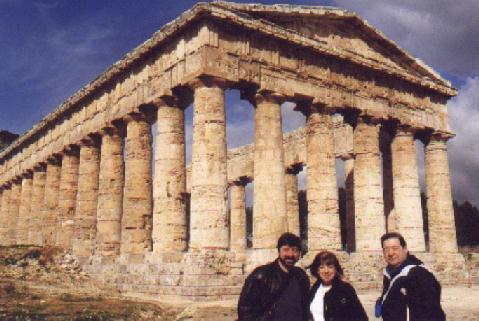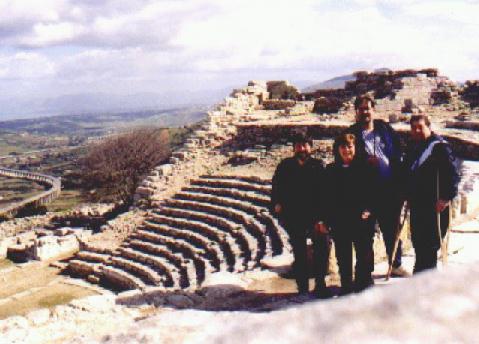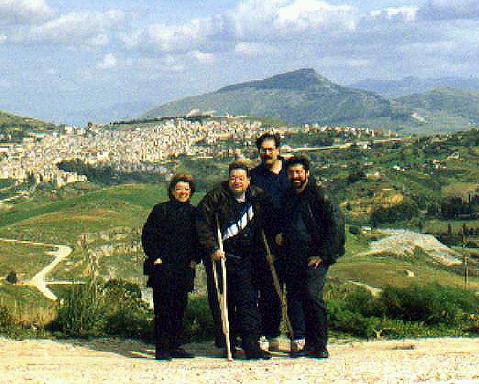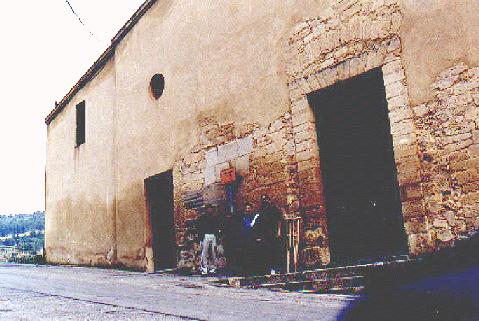
This is the story our the
Voltaggio family's trip to our ancestral
roots in Sicily during the week of 2/23/99.
We arrived in Sicily on 2/23 and stayed in Castellamare del Golfo
at the Hotel Al Madarig. This was our base of operations for
trips
to Calatafimi and Santa Margherita di Belice. The former is my
father's
ancestral home and the latter is my mother's. The players are
Nick
Voltaggio, eldest son of Gaetano Voltaggio and Lillian Monteleone,
Frances
Voltaggio Bielaczy, their daughter, Thomas Voltaggio (me), their
youngest
son and Christopher Voltaggio, Nick's son.
Here is a shot of the adventurers outside of the Hotel Al-Madarig in Castellamare del Golfo, our base of operations for the trip in Sicily.

February 24
After a nice buffet breakfast, we
were off for Segesta. It
took Nick a while to walk up the hill to
the temple, but it truly was a sight to see. Standing alone
on the top of a hill with nothing around,
it truly gives a feel of being taken back in time to the 4th century
BC.

We then bought souvenirs at the gift shop/bar and got on the little bus to go up the hill to the amphitheater. Again, the views from the amphitheater are stupendous and many pictures were taken.

From Segesta we drove to the monument
at the site of the Battle of
Calatafimi. Before we got
there, however, we stopped at the entrance to Calatafimi and were
another hilarious sight as we
took each other's picture at the Calatafimi sign. This time
the castle was on the hill over our
heads and the temple of Segesta directly behind.
Driving to the top of the hill by the
monument to Garibaldi, we walked
out to the crest of the hill
where Garibaldi and the Thousand charged up and broke the line of
the Bourbon soldiers. At the
spot is a small arch which has inscribed on it: "Qui si fa L'Italia
o si muore" (Here we make Italy
or we die). Legend has it that this was the cry from Garibaldi
at the crucial part of the charge up
the hill, when his line was faltering. The Thousand then
renewed
their charge and broke through.
The hillside is now a vineyard, but still shows the original slope
from 1860. From this vanatage
point, we took pictures of the town.

Here are my sister Fran, my brother
Nick on the crutches, my nephew
Chris (Nick's son) and me
at the monument, with the town in the background.
February 26
We decided to use this day to explore
Calatafimi on our own, so we
could spend time with the
cousins on Saturday, without pressure to see things impinging on
our visit.
The first stop was the railroad
station. We all recalled Mom
and Pop's story of arriving at the
station and finding it deserted and a long way from town.
Well, it was deserted and a long way
from town. Chris was especially excited about it being the
spot where, not only Mom and Pop
came to, but also where Nicola Vultaggio left from to begin his
journey to America.
We entered Calatafimi, proper, and
explored the town from top to
bottom! First we drove up to
the 5th century Castle Euphemius, from which Calatafimi gets its
name. When the Moors
conquered the town, they named it Kalat-al-Fimi by arabizing Castle
Euphemius. The Italians,
then italianized it to Calatafimi. Nick did a great job of
climbing seemingly hundreds of steps to
get to the top. Once there, it was a great site, with vistas
in all directions, including the town, the
monument to Garibaldi, Segesta, etc. This is
a view of the rebuilt ruins of the castle.

We went to the 12th century Chiesa
Madre (Mother Church). It
was closed, of course, so we
decided to go down the hill a bit and see the church of SS
Crosifisso.
This is the church that Gino
and Giovanna go to and is known for the famous black crucifix, which
is paraded through town
every few years in a huge feast. It was open and as we were
walking to it, we saw the priest who
I saw last June getting into his car. I approached him and
explained who I was (he didn't
remember me), but invited us into the Church. Fran, Chris
and I stayed awhile and saw the
crucifix and the litter, upon which it is carried during the
procession.
As we left the church, we were lucky
enough to spot Father Scavurzo
returning to the rectory of
the Chiesa Madre. I approached him and told him who we were
and showed him the book in
which Pop wrote about our genealogy and also showed him the
reference
to his name. He
remembered the work he did for Pop and opened the church for
us.
On a lark, I asked him if we
could see the old registers and he said OK!! We went to an
old closet in his office in the church
and there they were; more then a dozen unbound volumes by date for
baptisms and marriages.
The bindings had come apart and he covered the pages with plain
white, heavy paper and rubber
bands keeping it all together. He asked which date I wanted
to see and I picked the date of the
oldest reference that they found during their research - a 1600
marriage of our great, great, great,
great, great granduncle, Pietro Vultaggio. Sure enough, we
found the reference in the index of
the book, but not the actual entry. It was there, but he
couldn't
find it real easily in the time he
had. The books were incredible. They are about 11" high
and only 6" wide. They are hand
written and very, very hard to read. The paper is in
pretty good shape and some of the ink is
dark and others are light. The handwriting is awful!
He was very kind and we showed our
appreciation with expressions of thanks which were as flowery as
my limited vocabulary could
provide. We also walked all around the Church and were awed
by the thought of walking where
10 generations of antecedents walked over the past 500 years.
Here are the crew posing outside
the front of the Chiesa Madre.

We then drove to a square and parked
again. We walked all through
the town and bought some
souvenirs from a little shop on the Via dei Mille. This was
the street that Garibaldi and his army
marched up after the battle. The shopowner's name was Signor
Simone (another name from our
past - this time a maiden name of one of our great
grandmothers).
Each of the men bought a
Sicilian cap (a Coppola)! Signor Simone pointed out a food
store which was owned by a Vultaggio.
We went there, but the man's wife was busy and couldn't
talk.
We then went to Via Como, an
address that my father remembered writing to as a child when
he corresponded to his grandmother.
On the corner was an abandoned church, called Santa Maria
Maddelena. This probably gave the
name to the old section of town which Pop referred to as: "La
Maddelena".
It was time for lunch, so we asked
Signor Simone for a recommendation
and he suggested the
Milli Pini hotel, next to SS Crosifisso. The ristorante was
deserted and we were the only
customers. We ordered lunch and thoroughly enjoyed eating
on the spot where many of our
ancestors trod. There were many old photographs of Calatafimi
on the walls of the restaurant,
including one of Garibaldi entering the town.
After lunch, we drove around town
some more, ending up at the cemetery
on the extreme eastern
part of the town, overlooking a beautiful valley. Father
Scavurzo
had said that there were no old
cemeteries where our older ancestors were buried. They were
just buried without headstones in
one large area. The new current cemetery had vaults above
ground (very few graves). Most all
were dated after 1950. We found a few Vultaggios, Adamos,
Simones and many more Vivonas
there. As we were driving in that part of town, we passed the
Oratorio
of Santa Maria del
Giubbino. It is an old chapel in an enclosed area. This
is the church named after the patron saint
of Calatafimi. Gino told us that there is a large silver
framed
picture, which is also carried in a
procession through town and out onto the fields every year.
It remains in a small chapel in the
fields until harvest. Nick remembers Pop mentioning this.
We also found the City Hall
(Municipio), where Pop had met with Giovanni
Gerbino to see his
father's records in the town archives. It was closed, but
was very impressive, having been
recently restored. Next to it was the house the Garibaldi
stayed in after the battle. There was a
historical marker which stated that Garibaldi first raised the flag
of Italy at that spot, one day
after the battle.
After a drive down the Via dei Mille
out of town, we returned to
Castellamare, totally thrilled
with the magnificent day we had. After a meal on the dock
in La Cambusa again, we retired for
the night.
February 27
On our way to meet cousins Gino and
Giovanna and family, we stopped
by the dock in
Castellamare for Nick to take pictures of the picturesque dock area,
with the fishing boats and
fishing nets all about. We arrived at Gino's house a little
after 10 am and were warmly greeted by
the family. Giovanna and Lena and little Luigi were there,
with little Vito scheduled to be
returning from school at about 2 pm and Irena (big Vito's fidanzata)
arriving at that time as well.
We had a cup of coffee (better described as ink) and some cookies
and talked about families,
showed pictures and exchanged gifts. The furbies that Chris
brought for the grandchildren were a
big hit and a source of amusement to us all. Imagine trying
to explain furbies in Italian! We also
showed Gino and Giovanna Pop's book, which they apparently have
never seen. Giovanna was
very excited to see their wedding picture and a letter from Gino's
mother announcing their
engagement in the book.
While the women were preparing
dinner, Gino accompanied us to a few
other places around
town. We asked to see the cemetery, thinking that maybe there
was an older one. Our hopes
increased when Gino guided us a different way, but were dashed when
we realized that it was a
different way of getting to the same place. After that, we
went into town, because Chris wanted
to go to a gift store that he saw the previous day. Gino had
a better place, but it was closed
(much to Nick's chagrin, after walking some way to get there).
We found the original store and
bought some nice gifts there.
After that I asked Gino to take us to
Via Aquanova, another street
that Pop wrote to when he
corresponded with his aunt and cousins many years ago. Gino
brought us to two different homes.
One was the house his grandmother and mother lived in and the other
the house that his father
and mother (and he) lived in after their marriage. They were
only a few houses apart. The second
one was the one that Mom always referred to as "primitive" regarding
plumbing as she recalled
her trips to Calatafimi.
Gino then took us to his "summer
place". It was a small one
story building on a hillside
surrounded by fruit and olive trees overlooking the beautiful valley
to the east of Calatafimi. He
keeps his three dogs and his tractor in a garage there and goes
there to live for the summer. He
has a small kitchen, two small bedrooms and an eating area which
opens up to the outside. It was
delightful.
By then, we were ready to return to
Gino's for la pranza! It
was a great meal of assorted salamis,
olives and cheeses for antipasto, baked spaghetti with fennel
and sardines for primo piatto,
breaded veal cutlets for secondo piatto and fruit and cannoli's
for dessert. Dinner conversation
was lively and we had great fun interrelating with our cousins,
who Fran, Nick and Chris had
never met, but heard about for so many years.
After several more hours, we bid our
cousins farewell and left Calatafimi
in search of the famous
sulfur spring that we remember Pop writing about. We did find
it on the road to Segesta, but it
was closed for the winter. In the parking lot, we could easily
smell the strong sulfur odor. There
is now a modern community pool right alongside of the old sulfur
spring.